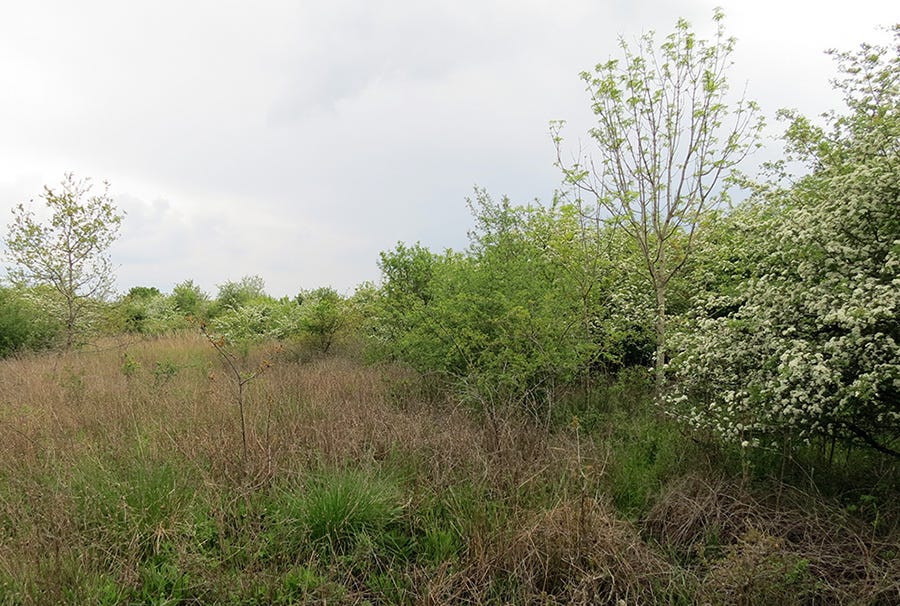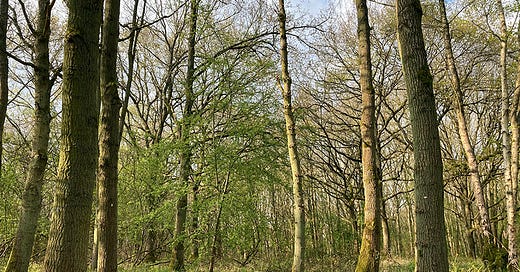Tree planting or natural colonisation: Help inform future forestry policy
Should human assistance be the default method for tree growing?

As an informed Tree Talk subscriber, you must be very aware of the UK Government’s ambitious tree planting targets. By their very nature, these targets suggest the default method for growing more trees is with human assistance. But is this an assumption? We need your help to inform future forestry policy.
Each tree is like its own planet. From the canopy of each tree, you’re given a new view of the Earth below. From the ground, you can look up into a web of branches that form the contours of its particular terrain. Beyond sight, each tree has its own sensory quirks, just like a planet; with rough or smooth bark, like bumpy or flat ground, and distinct smells, like a mini atmosphere. In this respect looking at a collection of trees is like looking at an arboreal solar system, sometimes the planets/trees are uniform in size and appearance, sometimes they differ greatly.
Unlike planets, trees are rooted to the same spot on this Earth. But how did each of these tree planets come to be rooted where they are?
Did a human help plant a sapling that started its life in a nursery? Or did the tree establish through the natural processes of seed dispersal, whether from a mother tree nearby, or an animal snacking and transporting it afar (known by ecologists as natural colonisation)?

The unique history of each tree can be divided into these two methods of establishment, planting or natural colonisation. However, when scaled up from a single tree to a woodland level, the history of a group of trees could also be a mix of these methods, known as a hybrid approach to establishment. Whether establishing a single tree or a potential woodland, it is up to the custodial land managers to choose which of these establishment methods is best suited to the land and their objectives.
I’m a social scientist at Forest Research working on the TreE_PlaNat project, led by University of Stirling and in collaboration with partnering organisations*. TreE_PlaNat is investigating the social and ecological factors behind land managers’ decision-making around establishment methods for woodland expansion. Here, the alternative meaning (and spelling) of ‘PlaNat’ is referring to the methods of Planting and Natural colonisation. I work on the social side of the project and we have a national survey live seeking the views of land managers of all types around which methods they would choose and why, if they were intending to expand a patch of woodland.
This is an opportunity to help improve our knowledge around this topic by donating 15-20 minutes of your valuable time to complete our survey: https://peopleandtreesurveys.limesurvey.net/593382
Understandably, you may ask why should I?
As mentioned above, the development of Government tree planting targets clearly indicates the default method for growing more trees is with human assistance. As the default establishment method, most of the policy, grant schemes, and procedures are set up to serve this approach.
But perhaps we should all just be allowing trees to grow naturally?

As neutral researchers, we need to know what method different landowners and managers would choose, because this research will inform the next wave of policy thinking, and ripple out across funding schemes and practitioners. It will impact the next generation of land managers, and quite literally shape our future arboreal solar systems. It is of the utmost importance that our results accurately reflect the views of a varied group of land owners and managers, for whom there are many different objectives informing their choice on tree establishment approaches.
We want to hear from anyone that identifies as one of the following:
- Work for an environmental NGO or charity
- Is part of a community woodland group
- Is a small woodland owner
- Is a medium/ large woodland owner or forest manager for a company/ landowner
- Work for an estate in land management
- A farmer – regenerative and conventional
- Work on land management for utilities companies
- Work for a local authority or planning authority (e.g. National Park Authority, councils)
- Work for another public body managing land e.g. MOD, Environment Agency, Crown Estate, Church of England (i.e. site managers and strategic planners)
If you identify as a land manager but do not feel that you fit into one of these categories then there is an ‘other’ box too. Here’s the survey link once more, in case you missed it: https://peopleandtreesurveys.limesurvey.net/593382
If you’re not convinced already, there is also a prize draw – thank you for helping to shape the future arboreal solar systems!
Rachel Orchard is a Social Scientist at Forest Research
Further reading: Factsheet: Case studies of woodland creation through natural colonisation
*TreE_PlaNat partnering organisations include: Forest Research, Woodland Trust, The National Forest, University of Edinburgh, and Royal Holloway University of London. For more information on the project, and the national survey, please visit: www.wren-project.com/tree-planat-survey.html. The survey closes on Wednesday 28 February 2024.




Fascinating article; so important that we explore all perspectives. I don’t fit into any of the categories for the survey, but as a citizen-nature-guardian I’ll share it in my networks....6 degrees of separation and all that!